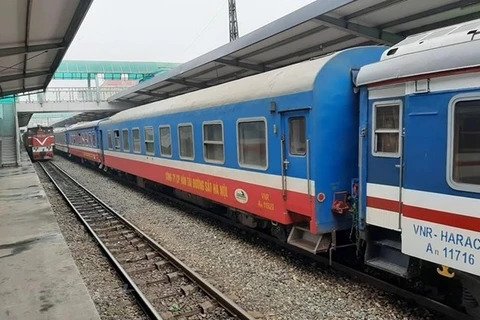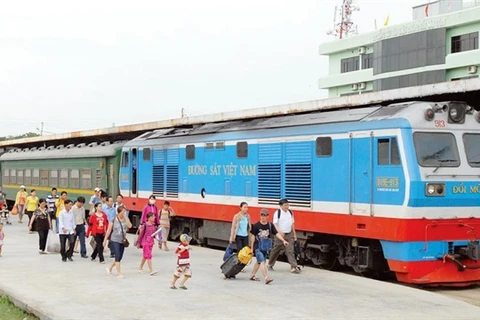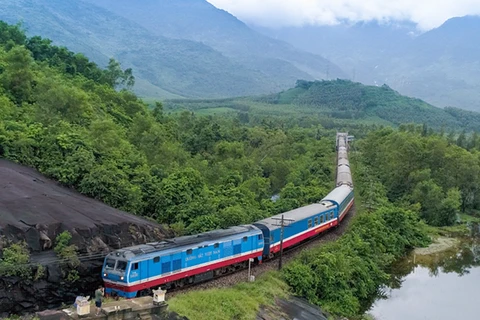Hanoi (VNA) – The railway sector will have to face huge financial pressure if it replaces expired locomotives and carriages.
The Vietnam Railways Corporation (VNR), therefore, has proposed extending the expiry for the old carriages, while seeking investments from different economic sectors in order to ease the burden.
Pressure from big investment capital sources
In pursuant to Decree 65 that prescribes a numbers of articles of the Railway Law and came into force from July 1, 2018, the lifespan of locomotives and carriages should not exceed 40 years for passenger trains and 45 years for cargo trains.
At present, the VNR is managing 282 locomotives, of which 262 are in use. The remaining 20 are left idle because they are too out of date, have low capacity and consume lots of fuel while repairs are too expensive.
Data of the VNR showed that 121 locomotives will not be used from the beginning of next year to 2026 due to the expiry-related rules, leaving it with only 141 by 2026.
Also under Decree 65, the VNR will have 196 locomotives by the beginning of 2022, but it usually needs about 217 to serve passengers during the Tet (Lunar New Year) holidays.
The Hanoi Railway Transportation JSC (HARACO) said between 2020 and 2025, it will have up to 1,092 carriages, including 986 of passenger trains and 106 of cargo trains, coming out of use.
To ensure its normal operationd, by 2025, HARACO needs about 240 billion VND (10.36 million USD) each year to build new carriages, thus meeting the increasing transport demand.
Saigon Railway Transport JSC (SRT) also said that from now till 2023, it will stop the operations of 98 passenger carriages and 347 cargo ones. The company aims to invest in eight luggage carriages, 15-30 passenger carriages and 150-300 cargo carriages annually during the 2020-2025 period.
HARACO Deputy General Director Nguyen Hong Linh said his company can afford only 30 billion VND each year. Meanwhile, it is hard to access huge loans from banks.
“To get bank loans, the reciprocal capital must be at least 30 percent of the total investment. It is a challenge to businesses,” Linh added.
To have enough locomotives, the VNR started a project to invest in buying 32 new locomotives in 2016. However, the project is still in the research stage.
Each new locomotive would cost about 1.5 billion VND (65,200 USD), so a great deal of investment was needed.
VNR Chairman Vu Anh Minh said investing in new equipment would put a lot of financial pressure on railway enterprises.
Minh said that the VNR had worked with different foreign partners to discuss investment methods to get more new trains while reducing this pressure.
“The partners will build new trains and the VNR will rent them. When the renting period ends, the trains will belong to the VNR. In fact, it is paying by instalments,” said Minh.
The price to make a train could also be cut by 10 percent by avoiding intermediate expenses.
“With the form, the railway sector can replace all out-of-date carriages, and the more important thing is that it will help improve the sector’s quality because it can learn from experience and access modern technology,” said Minh.
Both HARACO and SRT affirmed that they are seeking investors with a range of incentives.
While awaiting investments, the VNR has asked the Ministry of Transport to propose Prime Minister Nguyen Xuan Phuc extend the expiry for locomotives and carriages by three years.
It has also proposed transforming the purposes of 194 carriages that are expected to have no expiry date.
The VNR has projected losses of more than 1.2 trillion VND (51.7 million USD) this year.
The company earned revenue of 4.08 trillion VND in the January – August period, equivalent to just 77.8 per cent of the same period last year and 64.4 per cent of its expected revenue for the full year.
Minh said that slow innovation coupled with the impact of the COVID-19 pandemic had pushed the railway industry into difficulties unprecedented in more than a century of its history although the company has made efforts to attract passengers and increase revenues in recent years.
The VNR was calling for the Government’s supports to overcome the difficulties, Minh said, adding that it could take three to five years for the railway industry to recover.
The VNR hopes to be provided with exemptions and reductions in fees for using railway infrastructure, land use fees, extensions of deadlines for debt payment and interest rate cuts./.
























